Today’s French Press is about a subject near and dear to my heart: campus free speech. I explore a strange and troubling paradox. Just as college students are gaining freedom from the speech codes and official censorship of years past, many students feel under siege. They are free, but they don’t feel free. Let’s explore why.
Campus free speech litigators: All they do is win, win, win.
Back in the day, when I was a full-time First Amendment litigator directing the Alliance Defending Freedom’s Center for Academic Freedom, one of our most interesting and impactful cases was Badger Catholic v. Walsh. My colleague and good friend Jordan Lorence took the lead in a case revolving around one of the most underappreciated constitutional scandals in the American academy—student activity fees.
Here’s generally how the system works. Universities impose hefty annual or per-semester fees in addition to tuition. The separate funds are often used to fund ideologically neutral activities like, say, intramural sports, but vast amounts of money are channeled into specifically and intentionally ideological enterprises. Student fees prop up interest groups, and sometimes they support ideologically driven campus “centers” dedicated to gender equity or LGBT equality.
The end result is that students are involuntarily forced to fund an enormous amount of campus activism. It’s a comprehensive system of compelled speech that would be shockingly unconstitutional virtually everywhere but the academy, where the Supreme Court has ruled that the university’s educational mission gives it the authority to compel student funding student expression.
But there’s an important constitutional catch—the funding is supposed to be dispensed on a “viewpoint neutral” basis. It’s supposed to be available to religious and secular groups alike, to conservatives and progressives, without regard to their spiritual and political viewpoint. It’s a requirement that many universities observe mainly in the breach—dribbling out the smallest amount of money to religious organizations and political conservatives while lavishly funding progressive activism.
That was the situation at the University of Wisconsin. The school prohibited any student fee funding for worship, proselytizing, or religious instruction. Because worship, proselytizing, and religious instruction basically summed up the entire purpose of Badger Catholic, the largest student group at the university, it was barred from receiving any student fee funding. Badger Catholic sued, and it ultimately secured one of the more decisive victories in campus free speech litigation, winning hundreds of thousands of dollars of student fee funds from the university and the right to seek such funds so long as the student fee funding system exists.
Ultimately, my friend Jordan shook free millions of dollars in funding for religious speech on campus.
The story of campus free speech litigation has been case after case after case like Badger Catholic. Twenty years ago, college students faced a wall of official censorship and unconstitutional bias. The vast majority of campuses had enacted speech codes (policies that prohibited constitutionally protected speech), many of them supplemented speech codes with small “speech zones” that limited expression to tiny corners of immense public campuses, and some also administered blatantly biased student fee systems, forcing students to fund left-wing interest groups while largely shutting out conservatives.
Two decades of relentless litigation and activism—from ADF’s Center for Academic Freedom, from the Foundation for Individual Rights in Education, from the Becket Fund, and from new groups like Speech First (among others!)—have turned the tide. Only a quarter of universities now possess clearly unconstitutional speech codes, and they’re largely unenforced. Speech zones have been expanded (or struck down entirely) at campus after campus. The bottom line is that students at American universities are far more free from official censorship now than they were 10 years ago. At many universities, religious and conservative students have far more access to substantial funding than they did a generation ago.
Campus free speech isn’t secured by one big case or even ten big cases. Precedent builds on precedent to slowly grind official censorship into dust. The best comparison is to a legal version of World War I trench warfare. Campus censors withdraw slowly. They give ground grudgingly, only after bitter and lengthy court battles, but each new victory takes new legal territory. It restores liberty for more students -- today and for the days to come.
Earlier this month, ADF’s Center for Academic Freedom reached one of the most significant recent settlements in academic litigation history, and Twitter was largely silent. The media remained mainly ignorant. The victory mattered, however, and the legal principles articulated in Badger Catholic (and cases like it) were vindicated yet again.
The facts of the case were relatively simple. ADF sued California State University-San Marcos after it denied a pro-life student group a mere $500 in funding to help bring a pro-life speaker to campus. At the same time, however, it was providing approximately $300,000 in student fee funding to various left-wing centers on campus. Moreover, the university dispensed its funds through an opaque process that virtually invited viewpoint discrimination.
Last August, federal district judge James Lorenz (a Clinton appointee) not only struck down key elements of the San Marcos student fee policy, it denied the individual defendants motion for qualified immunity, holding they could be held individually liable for their constitutional violations.
In response, the entire California State University system waved the white flag. The settlement agreement not only granted the pro-life student group a modest amount of immediate funding, it transformed the student fee funding process for the entire system and stripped student-fee funding from San Marcos’s highly ideological campus centers. Now and for the foreseeable future, hundreds of thousands of California students will experience more freedom and more fairness. Free speech wins again.
But still, students don’t feel truly free.
So, if the free speech policies of America’s universities are far, far better than they were in the recent past, why is it that it’s now received conventional wisdom in conservative America that there’s a free speech crisis on campus? Part of the problem is that social media magnifies and nationalizes each and every lurid and crazy campus crisis—we take the actions and response of one campus and apply it to the whole. We perceive the problem to be greater than it is.
But there’s more. There’s a problem that’s as old as the middle school cafeteria—peer pressure. Increasingly campus intolerance is coming not from administrators and faculty members (indeed, they’re often as frightened as anyone) but rather from student peers demanding ideological conformity and imposing social reprisals (and sometimes seeking official punishment) in response to “offensive” speech.
On February 5, ironically enough the day after ADF announced its critical legal victory for free speech on campus, three University of North Carolina professors released their own comprehensive survey of the state of free expression on their campus—one of the most prestigious state universities in the nation. It’s report on the culture of free speech on their campus was every bit as troubling as ADF’s legal victory was encouraging.
The Atlantic’s Conor Friedersdorf has written an outstanding summary of the survey’s results and implications. You can read it all here, but the bottom-line findings are simple (and troubling):
While majorities favor more viewpoint diversity and free-speech norms, an intolerant faction of roughly a quarter of students believe it is okay to silence or suppress some widely held views that they deem wrong.
Students across political perspectives engage in classroom self-censorship.
Students harbor divisive stereotypes about classmates with different beliefs, and a substantial minority are not open to engaging socially with classmates who don’t share their views.
Disparaging comments about political conservatives are common.
A strong majority of conservatives—68 percent—reported self-censoring to avoid controversy. But they weren’t the only self-censoring students. Almost half of moderates (49 percent) reported chilling their own speech, and so did 24 percent of liberals.
The reasons for the chilling effects weren’t hard to find. A quarter of conservative students reported fear that classmates would file a complaint against them based on their speech. Majorities of 68 percent of liberals and 57 percent of moderates reported hearing “disrespectful, inappropriate, or offensive” comments about conservatives “several times a semester.”
Conservatives were at the receiving end of these comments more than any other identified sub-group on campus.
Troubling results fill the pages of the survey. As Friedersdorf notes, “Roughly 92 percent of conservatives said they would be friends with a liberal, and just 3 percent said that they would not have a liberal friend. Among liberals, however, almost a quarter said they would not have a conservative friend.” Taken together, the survey paints the picture of a social and cultural campus climate where conservatives encounter mockery and derision and risk social ostracization for expressing conservative views.
These results help show why students are free (from government sanction) but don’t feel free (from cultural condemnation).
Now, to be clear, none of us is guaranteed easy speech. Part of the answer to cultural intimidation is personal courage. If you believe your ideas are right, valuable, and worthy of consideration in the public square, there’s a point at which there’s a moral obligation to speak. And in fact, collective silence can lead conservatives to believe they’re more alone than they truly are (and progressives to believe that they’ve won debates that have barely begun).
Further, there are good ways and bad ways to engage. Unfortunately, a number of conservative students have chosen the path of provocation over persuasion. They intentionally try to trigger extreme reactions from the most intolerant students and then seek victim status when they get exactly the reaction they hope.
In fact, as I write this newsletter, Twitter is aflame with footage of an angry mob chasing “gun girl” Kaitlin Bennett off the campus of Ohio University. Bennett gained notoriety for open-carrying an AR-10 rifle on Kent State University for her graduation pictures. Activists like Bennett and the angry mob need each other—they use their mutual presence on campus to validate their rage and anger.
Other campus conservatives have adopted the tactics of their most intolerant enemies and launch media campaigns to fire or punish progressive professors who engage in provocative speech. They marshal their own online legions to attack free expression and individual liberty—yet another self-defeating tactic that only empowers and motivates the progressive opposition.
But conservative misconduct does not justify broad progressive intolerance, and just as conservatives have an obligation to speak boldly and respectfully, universities possess a corresponding moral obligation to teach respect for thoughtful dissent and tolerance for earnest dissenters.
They should have zero place for the “heckler’s veto,” where coalitions of students block opposing students or outside guests from speaking on campus. They should eliminate so-called “bias response teams” that investigate allegedly “offensive” speech in the effort to educate students towards progressive cultural sensitivity. Removing speech codes is a necessary first step towards building a culture of free expression, but it’s hardly sufficient.
Students are free, and it’s their responsibility to speak. But students should also feel free, and that means building a culture of true tolerance for civil debate.
One last thing ...
NBA All-Star Weekend has come and gone. The game itself was a spectacular success (google “Elam ending” to figure out what was going on), but the dunk contest was on another level. How do human beings do this:
Or this:
Or this:
Tacko Fall is 7-foot-5, by the way. NBA action, it’s faaantastic!
Photograph of Kaitlin Bennett at a protest on the campus of Kent State University in 2018 by Shay Horse/NurPhoto via Getty Images.







Please note that we at The Dispatch hold ourselves, our work, and our commenters to a higher standard than other places on the internet. We welcome comments that foster genuine debate or discussion—including comments critical of us or our work—but responses that include ad hominem attacks on fellow Dispatch members or are intended to stoke fear and anger may be moderated.
With your membership, you only have the ability to comment on The Morning Dispatch articles. Consider upgrading to join the conversation everywhere.